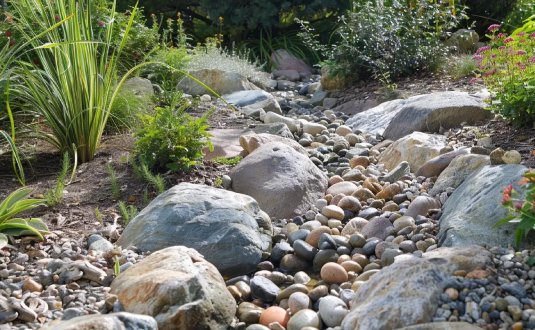Providing Best Services in Huntsville, AL
Providing Best Landscaping Services in Huntsville, AL



.webp)
What is Mow Over Landscape Edging?
Mow-over landscape edging is a low-maintenance solution that creates clean lawn boundaries while allowing easy mowing. Sitting flush with the ground, it eliminates manual trimming and prevents grass overgrowth. Durable materials like concrete, brick, and metal ensure long-lasting performance, making it a practical choice for homeowners looking for effortless yard upkeep.
This best lawn edging option is typically made from concrete, brick, metal, or durable plastic, offering long-lasting results. Homeowners prefer it for its ability to create clean boundaries while reducing time spent on yard upkeep. Proper landscaping installation ensures an even surface that integrates seamlessly into the garden.
Benefits of Mow-Over Landscape Edging
Mow-over landscape edging provides a seamless transition between lawns and garden beds, making it one of the best lawn edging options for effortless maintenance. Since the edging sits flush with the ground, lawnmowers can cut grass right up to the edge, reducing the need for trimming.
Durability is another advantage. Materials like concrete and metal withstand weather changes and heavy foot traffic. Properly installed edging prevents grass overgrowth and soil erosion, keeping outdoor spaces tidy. For areas prone to excessive moisture, integrating drainage solutions helps manage water runoff, preventing shifting and erosion.
Best Materials for Mow-Over Landscape Edging
The best materials for mow-over landscape edging are concrete, brick, metal, and plastic, each offering different benefits based on durability, cost, and maintenance.
Concrete provides long-lasting stability, lasting over 30 years with minimal upkeep. Brick offers a classic aesthetic and resists weather damage. Metal is thin and flexible, making it ideal for curved designs while preventing grass spread. Plastic is the most affordable but less durable than other options.
Healthy soil improves edging stability, and soil amendment and repair enhances drainage and plant growth, helping maintain a solid foundation.
What is the best landscape edging material?
The best landscape edging material depends on durability and use case. Concrete lasts 30+ years, making it the best edging for yard sections needing permanent borders. Metal is flexible and ideal for curved lines. Brick adds a classic look. For a modern yard, the best lawn edging is flush-set steel or concrete. Landscape edging best suited for heavy foot traffic includes poured concrete with a compacted gravel base.
How to Install Mow-Over Landscape Edging
The best way to install mow-over landscape edging is by digging a trench, securing the material, and ensuring a level surface for smooth mowing. Proper installation prevents shifting and extends the edging’s lifespan.
Start by marking the edging line using rope or spray paint. Digging a 2–4 inch trench allows materials to sit level with the ground. Concrete, bricks, or metal strips should be positioned securely before backfilling with soil or gravel for stability. Compacting the surface prevents movement and keeps the edging flush with the lawn.
For long-term durability, landscape design services can provide structured plans to match different lawn layouts.
How do you cut lawn edging for mowing?
To cut lawn edging, score with a utility knife or saw, depending on material thickness. Plastic strips can be trimmed with garden shears. For metal or concrete edging, use a masonry blade or hacksaw. Edging mowing paths should be straight, and material must sit flush to avoid blade obstruction. Mowing and edging go together start with clean-cut lines before laying edging to define the mowing edge of lawn areas.
What is foundation edging?
Foundation edging protects your home's base by redirecting water and defining soil lines. It keeps mulch and plants in place while preventing water splash on siding. Foundation edging typically uses brick or concrete for stability. It should slope slightly away from the home and integrate with mow-over edging if possible for low upkeep.
Maintenance Tips for Mow-Over Landscape Edging
Mow-over landscape edging requires minimal maintenance but benefits from occasional cleaning and repositioning. Dirt and debris can build up over time, shifting the edging slightly. A quick hose-down or brushing helps maintain a clean lawn edge.
Seasonal changes, particularly freezing and thawing cycles, may cause some movement. Checking for loose sections and adjusting them prevents long-term misalignment. Installing landscape fabric underneath minimises weed growth, while occasional sealing prevents rust in metal edging.
Adding drainage solutions in problem areas helps prevent soil erosion, reducing the risk of edging movement after heavy rain.
Cost of Mow-Over Landscape Edging
The cost of mow-over landscape edging depends on the material, installation method, and project size.
Professional installation costs range from £5 to £50 per foot, depending on the material and labour involved. If unsure which edging suits a specific space, landscape design services can help structure outdoor layouts to match budget and durability needs.
What is the best low cost landscape edging?
Low cost landscape edging includes plastic rolls, wooden stakes, or trench edges. Plastic edging costs £1–£3 per foot and lasts about 5–7 years. Trench edging, using only a spade, is free and popular in natural yards. Rubber options made from recycled tires provide an affordable balance between price and lifespan.
What is lawn edger plastic used for?
Lawn edger plastic is a lightweight, flexible border option for garden beds and walkways. It works well for DIY projects where curves or low cost matter most. Edgers made of high-density polyethylene are UV-resistant and easy to cut. Lawn edger plastic is often used for temporary designs or small yards where long-term durability is less important.
Final Thoughts on Mow-Over Landscape Edging
Mow-over landscape edging is a practical and long-lasting solution for maintaining clean lawn boundaries with minimal effort. It eliminates the need for manual trimming, making yard upkeep more efficient.
Choosing concrete, brick, or metal ensures durability, while proper installation prevents shifting over time. Whether for residential gardens or commercial landscapes, this low-maintenance yard edging option offers both functionality and aesthetic appeal.
Frequently Asked Questions
Is Mow-Over Landscape Edging Durable?
Yes, materials like concrete, brick, and metal last 20–40 years with minimal upkeep.
Does Mow-Over Edging Prevent Grass Overgrowth?
It creates a barrier that stops grass from creeping into garden beds, reducing maintenance.
Can You Install Mow-Over Edging Yourself?
Yes, DIY installation is possible with proper trenching and material placement, but professional help ensures longevity.
Which Material Is Best for Mow-Over Edging?
Concrete and brick offer the longest lifespan, while metal provides flexibility for curved designs.
How Much Maintenance Does Mow-Over Edging Require?
Occasional cleaning, repositioning, and weed control keep it functional for years.
Stay Connected and Inspired
Get the latest landscaping tips, seasonal care guides, and exclusive offers delivered straight to your inbox. Don’t miss out on expert advice and ideas to transform your outdoor spaces.
Sign Up for Our Newsletter Today!


Your Next Idea Awaits
Stay inspired with our latest landscaping tips and trends.
.webp)
.webp)

.webp)
.webp)
.webp)
.webp)
.webp)

.webp)








.webp)
.webp)





